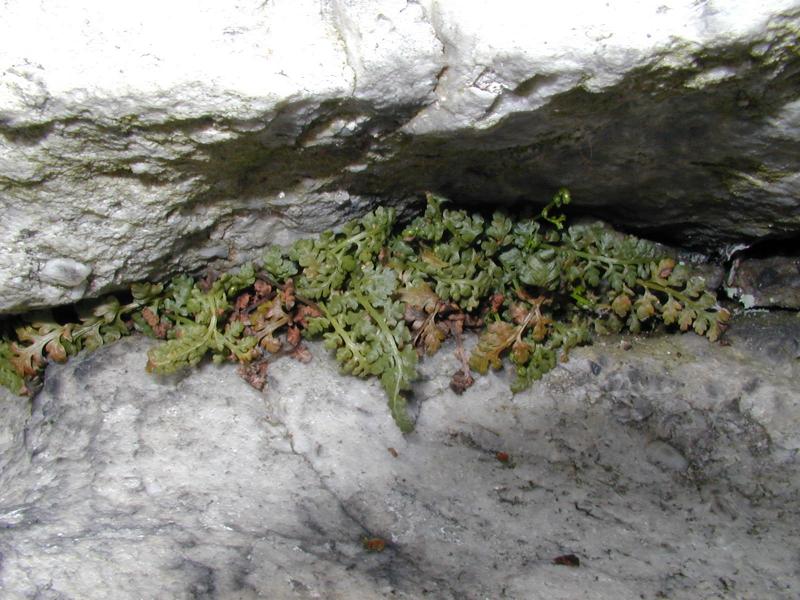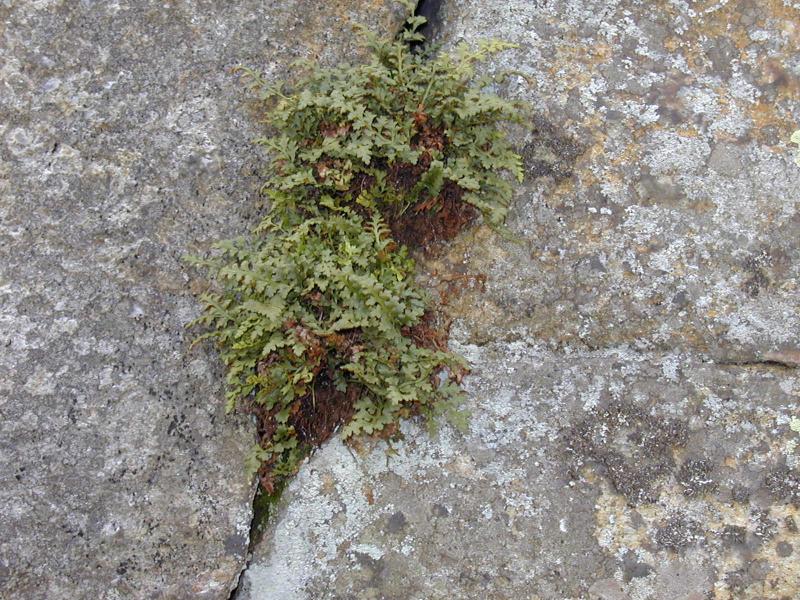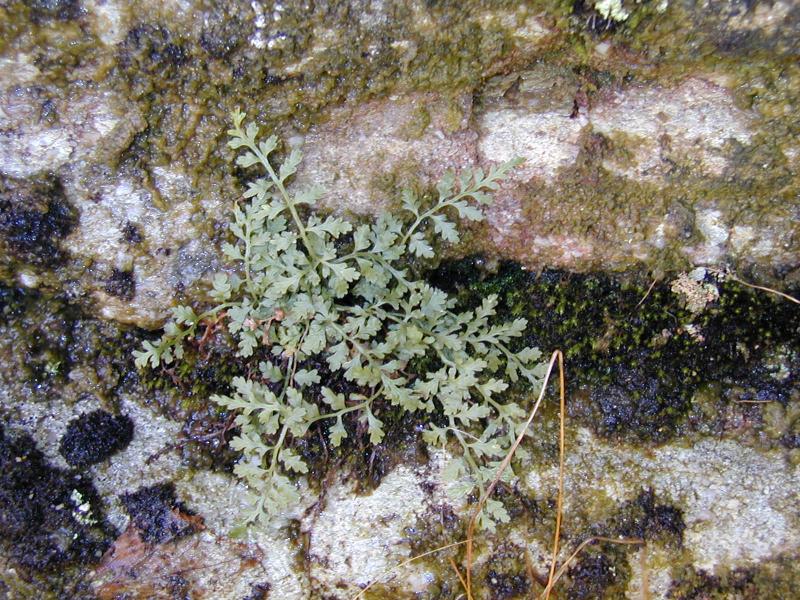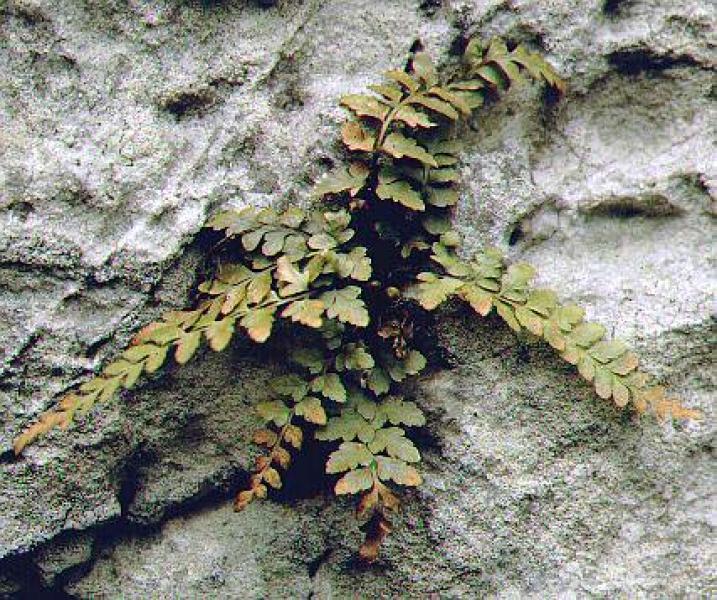Mountain Spleenwort
Asplenium montanum Willd.
- Class
- Filicopsida (Ferns)
- Family
- Aspleniaceae (Spleenwort Family)
- State Protection
- Threatened
Listed as Threatened by New York State: likely to become Endangered in the foreseeable future. For animals, taking, importation, transportation, or possession is prohibited, except under license or permit. For plants, removal or damage without the consent of the landowner is prohibited.
- Federal Protection
- Not Listed
- State Conservation Status Rank
- S2S3
Imperiled or Vulnerable in New York - Very vulnerable, or vulnerable, to disappearing from New York, due to rarity or other factors; typically 6 to 80 populations or locations in New York, few individuals, restricted range, few remaining acres (or miles of stream), and/or recent and widespread declines. More information is needed to assign either S2 or S3.
- Global Conservation Status Rank
- G5
Secure globally - Common in the world; widespread and abundant (but may be rare in some parts of its range).
Summary
Did you know?
This fern was first discovered in New York in the Mohonk Lake area in the 1870s. It seems restricted to the white conglomerate rock of the Shawangunk Mountains where the largest group in New York was found in 2003.
State Ranking Justification
This fern is relatively common within the small confines of the Shawangunk Mountains. There are at least 12 known populations within the Shawangunks and few threats except for unscrupulous climbing. As more populations are found, this plant may eventually be moved to the watch list. Arguably, the Shawangunk populations may represent one or only a few meta-populations with multiple sub-populations.
Short-term Trends
Many individuals are scattered in places within the Shawangunk Mountains that are difficult to access. These popualtions are typically not highly concentrated. Their numbers seem stable except in a few places where they may have been affected by rock climbers.
Long-term Trends
For the most part, this plant has always been limited to cliff-faces of the Shawangunk Mountains. The long-term trend has been stable overall but some local populations may have declined from rock climbing activity.
Conservation and Management
Threats
The impact of rock climbers may be a problem in some areas but not to the population as a whole.
Conservation Strategies and Management Practices
Most of the known sites are within protected landscapes, and these populations are located in areas that need little management. In a few locals, management plans may be needed to limit damage from rock climbers.
Research Needs
Research to study the impacts of rock climbing on this fern would assist land managers in determining where rock climbing can occur to best avoid negative impacts.
Habitat
Habitat
A fern of silurian conglomerate cliffs and outcrops along the Shawangunk Ridge, particularly on ledges, cliffs, and cracks and fissures of rock faces. These areas usually have a slight amount of moisture in the rock cracks, but the cliff face is relatively unvegetated (New York Natural Heritage Program 2004). Cliff-crevices in noncalcareous rocks (Gleason and Cronquist 1991). In shaded and sheltered crevices of sandstone, gneiss, and shale, where there are tiny pockets of acid soil (Cobb 1984). Shaded or sheltered crevices of chiefly non-calcareous rock (Fernald 1970).
Associated Ecological Communities
- Cliff community
(guide)
A community that occurs on vertical exposures of resistant, non-calcareous bedrock (such as quartzite, sandstone, or schist) or consolidated material; these cliffs often include ledges and small areas of talus.
Associated Species
- Betula populifolia (gray birch)
- Cystopteris fragilis (fragile fern)
- Danthonia compressa (northern oat grass)
- Deschampsia cespitosa (tufted hair grass)
- Kalmia latifolia (mountain laurel)
- Quercus montana (chestnut oak)
- Quercus rubra (northern red oak)
- Tsuga canadensis (eastern hemlock)
Range
New York State Distribution
Known populations of this plant are restricted to cracks, fissures, and ledges of the vertical conglomerate rocks of the Shawangunk Mountains.
Global Distribution
This fern may be found from Massachusetts, southern Vermont and southern New York to Ohio and Kentucky, south to Georgia and Alabama.
Identification Comments
General Description
A small, delicate, bluish-green fern which grows in drooping tufts within the crevices of overhanging white-conglomerate rocks. The abundant evergreen leaves are divided into six or more pairs of leaflets which are divided again into smaller segments with small lobes. The lowest pair are the largest and the leaflets rapidly diminish in size toward the tip of the leaf. The leaf stalk is brown at the base and green above.
Identifying Characteristics
A fern with a short rhizome that is about 1 mm thick. This stipe is dark at the base and green above, thence passing into the broad and flat green rachis. The frond is not parallel-sided but instead lanceolate to lance-oblong or lance-ovate. It is 2-3 times pinnate, at least towards the base, and there are 6-10+ pinnae with at least the lower ones cleft into cut-toothed pinnules.
Best Life Stage for Proper Identification
To properly identify this plant, one needs mature fronds including leaves, rachis, and stipe. If only a picture is taken, some sort of scale reference should be provided within the picture to allow for verification.
Similar Species
Bradley's spleenwort (Asplenium bradleyi) very closely resembles mountain spleenwort (A. montanum) and may reflect a hybridization of A. montanum and A. platyneuron. Bradley's spleenwort will have a blade that is oblong with nearly parallel sides. The blade of mountain spleenwort is much more triangular in shape, tapering to the apex.
Best Time to See
While remnants of this plant are visible year-round, the fronds brown considerably after frost. The result is diminished or even missing plants until new fronds appear in spring. Some plants will remain green year-round though. Surveys for this plant should occur between May and October.
- Vegetative
- Fruiting
The time of year you would expect to find Mountain Spleenwort vegetative and fruiting in New York.
Mountain Spleenwort Images
Images of Similar Species
Taxonomy
Mountain Spleenwort
Asplenium montanum Willd.
- Kingdom Plantae
- Phylum Filicinophyta
- Class Filicopsida
(Ferns)
- Order Filicales
- Family Aspleniaceae (Spleenwort Family)
- Order Filicales
- Class Filicopsida
(Ferns)
- Phylum Filicinophyta
Additional Common Names
- Single-sorus Spleenwort
Additional Resources
Best Identification Reference
Gleason, Henry A. and A. Cronquist. 1991. Manual of Vascular Plants of Northeastern United States and Adjacent Canada. The New York Botanical Garden, Bronx, New York. 910 pp.
Other References
Cobb, Boughton. 1984. A field guide to ferns and their related families. 281 pp.. Houghton Mifflin Co., Boston, New York. The Peterson Field Guide Series.
Fernald, M.L. 1950. Gray's manual of botany. 8th edition. D. Van Nostrand, New York. 1632 pp.
Holmgren, Noel. 1998. The Illustrated Companion to Gleason and Cronquist's Manual. Illustrations of the Vascular Plants of Northeastern United States and Adjacent Canada. The New York Botanical Garden, Bronx, New York.
Mitchell, Richard S. and Gordon C. Tucker. 1997. Revised Checklist of New York State Plants. Contributions to a Flora of New York State. Checklist IV. Bulletin No. 490. New York State Museum. Albany, NY. 400 pp.
New York Natural Heritage Program. 2010. Biotics database. New York Natural Heritage Program. New York State Department of Environmental Conservation. Albany, NY.
New York Natural Heritage Program. 2024. New York Natural Heritage Program Databases. Albany, NY.
Reschke, Carol. 1990. Ecological communities of New York State. New York Natural Heritage Program, New York State Department of Environmental Conservation. Latham, NY. 96 pp. plus xi.
Weldy, T. and D. Werier. 2010. New York flora atlas. [S.M. Landry, K.N. Campbell, and L.D. Mabe (original application development), Florida Center for Community Design and Research http://www.fccdr.usf.edu/. University of South Florida http://www.usf.edu/]. New York Flora Association http://newyork.plantatlas.usf.edu/, Albany, New York
Links
About This Guide
Information for this guide was last updated on: May 31, 2006
Please cite this page as:
New York Natural Heritage Program. 2024.
Online Conservation Guide for
Asplenium montanum.
Available from: https://guides.nynhp.org/mountain-spleenwort/.
Accessed July 26, 2024.



